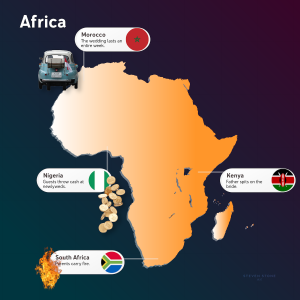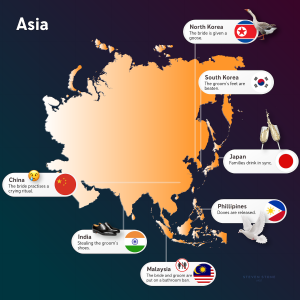Wedding traditions from around the world – To showcase the magic of culture, Steven Stone, has rounded up some of the most extreme wedding traditions from around the world.
Using a list of 195 countries and breaking them down by continent, they have showcased some of the craziest traditions, in a bid to reveal how different couples celebrate their wedding days.
From gifting the newlyweds, a goose to stealing the groom’s shoes, take a look and prepare to have your mind blown.

Europe
Whilst our European neighbours may only be a stone’s throw away, wedding celebrations can be dramatically different from the UK. From the type of cake served to the attire of the bride, you’ll be amazed at what happens on wedding days around the continent…
Norway: There’s a cake filled with gifts
If you attend a wedding in Norway, you can expect to LOVE the cake. A traditional Norwegian wedding cake is called a kransekake and is created by stacking iced almond cake rings on top of each other to create a cone shape. The best part? Inside of this hollow cake hides a selection of small gifts, like a bottle of champagne or wine.
At the party, the bride and groom will pick up the top ring of the cake and however many layers stick to it underneath is believed to be the number of children they will have.
Germany: The bride and groom use chainsaws
While still wearing their wedding attire, German newlyweds are sometimes known to saw a log into two pieces during the ceremony. This tradition is known as Baumstamm Sägen. As it’s a two-person saw, Baumstamm Sägen symbolises the couple’s strength as they face challenges in their marriage.
France: Pastries are served instead of cake
France is famous for its incredible pastries, so instead of a fruit-filled wedding cake being the star dessert, at most French weddings, you’ll be served = a Croquembouche, a beautiful dessert made up of small pastry balls stacked on top of one another.
Romania: The bride is kidnapped
In Romania, if the bride disappears, don’t be alarmed, as it doesn’t necessarily mean she’s got cold feet. It’s tradition for the bride to be “kidnapped” by friends and family before the wedding. Just like role-play, to get the bride back, the groom must pay her ransom, paying in romantic gestures or filling her glass with champagne.
Spain: The bride wears black
While it may seem a little strange, traditionally, a Spanish bride would wear a black lace gown and veil called a mantilla draped over her head and shoulders. The attire was designed to symbolise the devotion she has to her husband, and addressing the vow ‘till death do us part’? As for the veil, it was once thought that a bride who looked too beautiful would attract evil spirits, which is where the veil derived from.
Sweden: Tiaras are swapped for flower crowns
In Sweden, you’re unlikely to see a veil or tiara as the bride will always opt for a beautiful flower crown. Traditionally, a flower crown would feature a sprig of myrtle to symbolise love.
Now a common headpiece worn by bohemian brides, flower crowns has become a popular accessory around the world.
Italy: Nuts are given to newlyweds
Many of us think of confetti as colourful bits of paper that get thrown at the newlyweds, however, in Italian “confetti” refers to sugared almonds that wedding guests receive as favours at the reception. These used to be thrown at the bride and groom, but have been replaced by coriandoli, the tiny scraps of paper.
United Kingdom: Old, new, borrowed, and blue
In the UK, this fun tradition is based on an old rhyme by an unknown English poet: “Something old, something new, something borrowed, something blue, and a silver sixpence in her shoe.” On the day of the wedding, the bride must wear something old to represent the past, something new for the future, a borrowed item to symbolise the happiness given to the bride by the new husband, and finally something blue to ward off evil spirits. Nowadays, the final line about the sixpence is often practised, however, it historically referred to wealth.

Africa
If you attend a wedding in Africa, it’s important to know some of the most popular cultural traditions, as you could become easily offended by what you see. Thankfully, these traditions are all meant to bring good luck and prosperity – although you may need a fire extinguisher on hand in South Africa…
Kenya: Father spits on the bride
If you go to a wedding in Kenya, don’t be shocked if you see the father of the bride spitting on her dress for good luck. Hoping not to jinx the marriage, the spit is meant in good faith. For the Maasai people in Kenya, spitting on someone is seen as showing them respect.
Nigeria: Guest throw cash at the newlyweds
Guests at weddings in Nigeria aren’t afraid to splash the cash. It’s customary for guests to “make it rain” or toss bills at the bride and groom. This is a gesture to show the couple their happiness and to keep them on the dance floor.
Morocco: The wedding lasts an entire week
Although most of us are exhausted after one day of wedding celebrations, in Morocco, parties often last up to seven days. From pre-wedding ceremonies, preparation rituals and a huge wedding day feast, expect to book a week off work if you’re attending a Moroccan wedding.
At the start of the wedding week, the bride will go on a Hammam day to mark the beginning of a new chapter in her life. As a ritual of purification, the bride-to-be will visit a traditional sauna with her friends and relatives.
The bridal party will also have a henna party, each getting tattooed onto their hands and feet. Once they’re pampered, they’ll be pre-wedding feasts, the wedding day and the after-party, with lots of dancing.
South Africa: Parents carry fire
In parts of South Africa, it’s tradition for the parents of the bride and groom to bring fire from their own fireplaces to the home of the newlyweds. The bride and groom use the flames provided from their childhood homes to ignite the hearth in their new home together.

Asia
Traditions in Asia vary by country, from the gifts offered to newlyweds to the preparation leading up to the ceremony, each culture has a unique way of celebrating love.
Whilst crying is mandatory in China, the bride is busy looking after a goose in North Korea….
India: The groom gets his shoes stolen
In a traditional Indian wedding, it’s custom for the groom to remove his shoes, however as part of the Joota Chupai ritual, the bride’s female relatives often play a trick on him by stealing the shoes and hiding them. To get his shoes back, the groom must bribe the women with cash to return them before the ceremony.
Philippines: Doves are released
Following the wedding ceremony, Filipino newlyweds traditionally release two doves, one male and one female. The beautiful birds represent harmony and peace, whilst symbolising love for the newlyweds.
China: The bride practices a crying ritual
Whilst it’s expected to see a few tears shed at a wedding ceremony, in some parts of China the bride is required to practice crying. A month before the ceremony, Tujia brides are expected to cry for one hour each day. 10 days into the ritual, she is joined by her mother and 10 days after that, the bride’s grandmother joins in. Known as Zuo Tang in the western Sichuan province, the ritual dates to China’s Warring States era when the mother of a Zhao princess broke down in tears at her wedding.
Japan: Families drink in sync
Drinking wine at a wedding doesn’t sound too bizarre, however, in Japan, the historic tradition of san-san-kudo, requires the bride and groom to take three sips each from three flat sake cups, after which their parents do the same, bonding the families together.
Korea: The bride is given a goose
Most newlyweds are gifted accessories for their new home or money towards their honeymoon, however, in Korea, brides and grooms exchange wooden geese and ducks on their wedding day as a sign of their commitment.
Historically, grooms also give their new mother-in-law’s wild geese or ducks. The monogamous animals represent the groom’s pure intentions and loyalty to his bride.
South Korea: The groom’s feet are beaten
In parts of South Korea, grooms cannot leave with their new wives, until they’ve had their feet beaten. After the ceremony, groomsmen or family members remove the groom’s shoes and bind his ankles with rope before taking turns to beat his feet with a stick or, in some cases, a dried fish. Thankfully, the ritual doesn’t last long and is seen as a fun part of the day, meant to test the groom’s strength and character.
Malaysia: The bride and groom are banned from the bathroom
Members of Malaysia and Indonesia’s Tidong people in Borneo observe a tradition that states the bride and groom must not leave their home or use the bathroom for three whole days after their wedding ceremony and are kept under watchful guard and allowed only a small amount of food and drink. In Tidong culture, not observing the ritual is said to tarnish the bride and groom with bad luck often resulting in infidelity, the breakup of their marriage or the death of their children.

North America
Mexico: The bride carries two bouquets
While one bouquet is a tradition for many countries, in Mexico, it’s common for a bride to carry two of them when walking down the aisle. One bouquet for herself, and a second as a tribute to the Virgin Mary.
Guatemala: Mother of the bride breaks a white bell
We’ve heard of ringing the wedding bell, but breaking one? At a Guatemalan wedding reception, the mother of the groom breaks a white bell to welcome the newlyweds to the party. The bell is filled with flour, rice, and grains, is meant to bring luck and prosperity.
Jamaica: They serve Christmas cake
In the Caribbean, rum and raisin is a popular combination, so it’s not surprising to see these flavours in wedding cakes. Forget the icing, here, they often serve a very dark cake made from dark fruits and rum. The same cake can be served at Christmas and has a lot in common with a traditional Christmas fruit cake.
Cuba: The bride charges you to dance with her
Regardless of culture, it’s usually common for the bride to dance with her guests, however, in Cuba, the dance comes with a price. Every man who dances with the bride is traditionally required to pin money onto her dress. This is to help the couple pay for the wedding and honeymoon.


Australasia
If you’re planning a wedding down under, get set for some mind-blowing ceremonies and rituals. From proposing with a whale’s tooth in Fiji to tying the knot under a waterfall in New Zealand, guests are sure to be kept entertained.
Polynesia: The bride and groom are cleansed with coconut water
The priest will divide one Auti leaf making two bracelets and he will put them around your wrists to tie the knot, rather like the hand-fasting ceremony but with a local twist.
With the hands bound together, you will get blessed and your sins washed away with pure water from the lagoon or with fresh coconut water.
Australia: Guests are given special stones to hold
An Australian wedding ceremony might feature the tradition of a unity bowl. Upon arrival, guests are given stones which they are required to hold during the ceremony. When it’s over, guests then place the stones in a decorative bowl that the couple keep on display in their home, paying tribute to their friends and family who attended.
Fiji: The proposal involves a whale tooth
In Fiji, the groom and his family will often present the bride’s father with a sperm whale’s tooth when he asks permission. Though this practice is more common in rural areas, it’s practised all over Fiji. The tooth, known as a tabua, translates to “sacred” in Fijian.
Samoa: The bride’s dress is from the groom’s family
The first Samoan wedding tradition is that the bride’s wedding dress is from the groom’s family. Wearing a wedding dress from the groom’s side is a sign of respect to her fiancé’s family, which could be borrowed from any member of the soon to be in-laws, such as mother or sister, dependent on size.
New Zealand: A ceremony in geothermal hot springs
Couples with a Maori heritage often opt for a traditional ceremony, which can take place at the Pohtu Geyser, which features beautiful geothermal hot springs, thermal geysers and bubbling hot mud pools. The Maori people believe this is a sacred place. As the ceremony takes place, the Pohutu Geyser rises to the occasion, demonstrating a spectacular display of power by gushing water higher than 25 metres into the air.


South America
Imagine sneaking off from your own party without saying goodbye? That’s what you can expect in Venezuela.
Venezuela: The newlyweds secretly leave the party
In Venezuela, it is tradition for the newly married couple to sneak off from their wedding reception without saying goodbye to their guests. Interestingly, it is believed that this tradition brings good luck.
Peru: Single ladies seek love in the cake
If you’re a single lady, you’ll love this wedding tradition in Peru. A traditional Peruvian wedding cake has ribbons hanging out around the sides. Each ribbon is attached to a charm inside the cake; however, one special ribbon is attached to a replica wedding ring. If you’re served the wedding ring-filled slice of cake, Peruvian’s believe that you’re next in line to get married.
Argentina: The bride wears multiple garters
Argentinean brides have their own variation of the bridal garter game. The bride will in fact wear several garters and will give these away throughout the party to her single girlfriends.
Chile: Newlywed’s kiss when guests ring a bell
At the wedding reception, it is tradition for little bells to be placed on the guest’s tables and each time someone rings one, the bride and groom must kiss.
Poppy Watt


